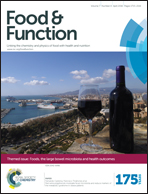In vitro bioaccessibility of proteins and lipids of pH-shift processed Nannochloropsis oculata microalga
Abstract
The pH-shift process fractionates biomass into soluble proteins and insoluble fractions, followed by precipitation and recovery of the solubilized proteins. Nannochloropsis oculata in seawater was subjected to the pH-shift process, followed by digestion of various intermediates and product fractions of the process, using the Infogest in vitro digestion model (Minekus et al., 2014) with added gastric lipase. As measures for protein and lipid accessibility, degrees of protein hydrolysis and fatty acid liberation were assessed post-digestion and compared to the amounts of peptide bonds and total fatty acids present in the raw materials. Results showed that neither proteins nor lipids of intact Nannochloropsis cells were accessible to the mammalian digestive enzymes used in the digestion model. Cell disruption, and to a lesser extent, further pH-shift processing with protein solubilisation at pH 7 or pH 10, increased the accessibility of lipids. For proteins, differences amongst the pH-shift processed materials were non-significant, though pre-freezing the product prior to digestion increased the accessibility from 32% to 47%. For fatty acids, pH-shift process-products gave rise to 43% to 52% lipolysis, with higher lipolysis for products solubilised at pH 10 as opposed to pH 7. Our results indicate the importance of processing to produce an algal product that has beneficial nutritional properties when applied as food or feed.


 Please wait while we load your content...
Please wait while we load your content...